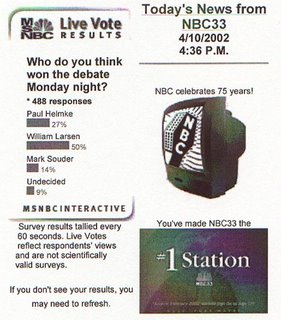Question - What is a pyramid Scheme?
Today on WOWO Charlie was describing the latest $50 Billion swindle on Wallstreet as a ponzi scheme. With billions of dollars invested from charities, retirees, pensions and others, he said this was like sentencing people to poverty or something to that affect. He came across as being totally disgusted that this occured and could happen. Well guess what, even though $50 billion is a lot of money it is a far cry from the single largest ponzi schem that is still in operation. So what is a ponzi scheme? The name comes from Mr. Ponzi who tried to give investors great returns.
The definition I have heard and use goes something like this:
A person, whom I will call the seller, asks another person, whom I call the investor, to invest in a scheme. The seller of the scheme asks for a lump sum or a periodic payment into an investment proposal from the investor. In return the seller promises a return to the investor. Normally the return is far greater than can be obtained by the seller. It is not based on any actuarial basis and the risks have not been fully disclosed nor identified.
The seller normally provides a statement showing how well the fund is doing. This statement shows the buyers investment is paying off as stated. This can be in dark contrast to a reality. The seller will show new prospective investors the statement as proof the investment is sound.
What normally happens is the first investors are being paid their promised returns from two sources. One source is real returns and the other is from the contributions of later investors. The seller was unable to earn the stated return on the original investors money. The seller is forced to use some of the money received, for investment, from new investors, and show it as a return on the original investors money. It is a game of moving money around to show investors good returns, keep them happy and unaware there is a problem.
When the seller can no longer enroll new investors, they have a problem. They can not indefinitely continue to pay unreasonable returns. Without new investors, the sellers cash flow is insufficient to pay promised returns to all the investors. When this happens, the investors tend to become angry with the seller. Those who were the last ones enrolled normally loose the most.
Old Age Survivors Insurance began with a low tax rate of 2% and promised to pay a return in the form of a benefit equal to 42% of ones average wage. Was this sound? Based on the investment vehicle (US Treasury notes), United States Wage Growth and Inflation at the time, the tax rate was over five times too low. It should have been 11.83% and this does not count the original unfunded liability based on some paying only a few years before benefits were paid.
Just as a pyramid scheme requires ever more participants to keep its current participants happy, Social Security ran into the same problem in the early 1950's. OASI ran into difficulty when the benefit expense began to grow faster than revenues. The US Treasuries were being redeemed thirty years before they should have been. This Trust fund should not have been tapped until well after all the original participants had retired. To keep the system afloat, they redeemed the treasuries masking the real problem. But some smart people finally realized the trust fund would be exhausted in a few years and the game would be up.
To keep the original participants happy (continue the payments of benefits) and make it appear Social Security was a great idea, they increased the OASI tax by 50% to 3% and then increased the Base by 50%. At the same time they enrolled more non covered workers into Social Security. This is exactly what a pyramid scheme needs to do in order to continue to survive. It needs new investors. The new participants contributed revenue but by and large would not retire for decades.
In the 1960's the problem became acute when once again Social Security began to run deficits and the trust fund was being redeemed much earlier than it should have. They then increased taxes, the base and enrolled all those workers who were not covered by Social Security. Again social security increased its revenues to pay current participants and keep them happy (buy votes and PR) while also increasing the tax and base.
By the 1970's the problem was really becoming acute. Almost every worker was covered. There were no more non-covered participants (suckers). The seller could not admit benefits would have to be cut to continue Social Security. The seller would loose the senior vote for sure. The only thing left to do was raise the tax and base even more. But even raising the tax and base proved insufficient and now the seller had to raise the retirement age.
Social Security is the "standard" for what a pyramid scheme is. I do not think there is any other pyramid scheme which has existed as long as Social Security, which has suckered as many people and which will destitute more families in the history of the world.
You can define pyramid scheme in two words "Social Security."
How much has Social Security Old Age Survivors Insurance promised to pay in currnent dollars? Well by my calculations it is just a tad over $19 trillion. How much does it have in the trust fund to pay these benefits? The SS-OASI trust fund has about $2.2 Trillion. In other words it is 90% unfunded.



0 Comments:
Post a Comment
<< Home